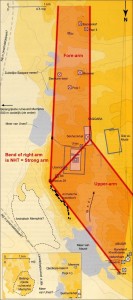Bend at Saqqara, depicting the Elbow of the Strong Arm = Nht
Near Saqqara, six pyramids were built and arranged to form a bend (fig.4). Professor Mark Lehner wrote about the subject as follows: ‘When Teti, first pharaoh of the 6th dynasty, built his pyramid northeast of Userkaf, a necklace of pyramids from the 3rd, 5th and 6th dynasties extended diagonally from northeast to southwest across the Saqqara plateau. The orientation is approximate, although a line can be drawn connecting the northwest corner of the pyramid of Sekhemkhet, the pyramid of Unas (but off-centre), the southeast corner of Djoser, the southeast corner of Userkaf and the centre of Teti. A small pyramid, almost destroyed (of Merikare or Menkauhor), east of Teti’s, extended the line of pyramids a little farther northeast to the edge of the escarpment’ (The Complete Pyramids, p.83). At this bend, the long, slanting part of hieroglyph T15 ends. I postulate that the bend corresponds to the elbow of the right arm. The surroundings of the bend at Saqqara represent the Strong Arm (Nekht). It is therefore self-evident that the region was also used to rebury the pharaohs of the 1st and 2nd Dynasties in the archaic mastabas.
